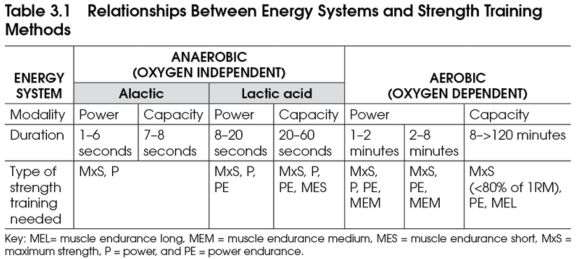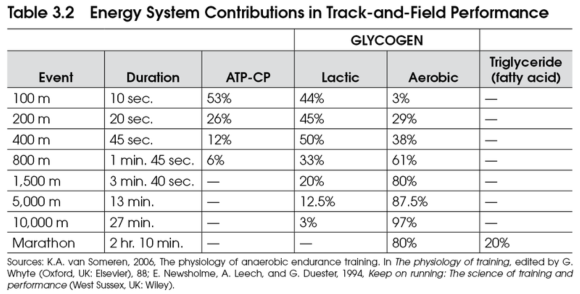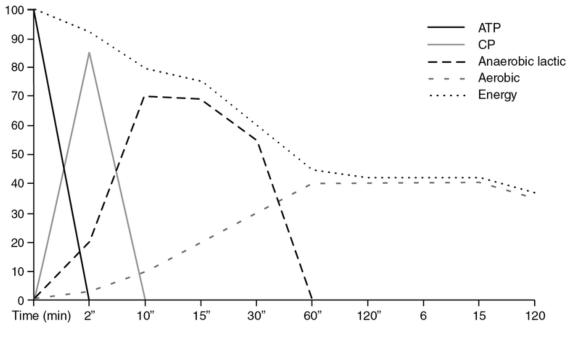Understanding energy systems training
This is an excerpt from Periodization Training for Sports-3rd Edition by Tudor Bompa & Carlo Buzzichelli.
Bridging the Theory - Practice Gap in Energy Systems Training
Coaches without real knowledge of energy systems often intuitively develop programs that train the dominant energy system for their sport. For instance, sprint coaches intuitively train their athletes with sprint distances even though they are unfamiliar with the benefits of such training on the nervous system and the anaerobic energy systems. However, energy systems training should also take into consideration the recruitment of muscle fiber types. Improvement in energy system efficiency depends on the neuromuscular system's ability to withstand the development of tension and fatigue resulting from chronic training. For instance, continual training of the anaerobic lactic system makes the fast-twitch muscle fibers able to generate force in the presence of lactic acid accumulation. This result is accomplished through an increase in motor unit recruitment and the reuse of lactic acid by the slow-twitch muscle fibers. Anaerobic metabolism can be maximized by designing a program that combines maximum strength and power endurance training with 150- to 400-meter sprinting.
The energy system tapped to produce energy during an athletic activity depends directly on the intensity and duration of the activity. The anaerobic alactic system primarily produces energy for all sports of short duration (up to 8 to 10 seconds), in which speed and power are the dominant abilities. Alactic system-dominant sports include short sprinting, throwing and jumping events in track and field, ski jumping, diving, vaulting in gymnastics, and Olympic weightlifting. The movements in these sports are explosive and of short duration and use high loads; in other words, they require maximum strength and power. Therefore, the anaerobic alactic energy system is used in conjunction with the recruitment of a high number of fast-twitch muscle fibers (for maximum strength) and an increase in the discharge rate of those fibers (for maximum power).
The anaerobic lactic system, on the other hand, is the main energy provider forhigh-intensity sporting activities of prolonged duration (15 to 60 seconds). A partial list of anaerobic lactic system-dominant sports includes the 200- and 400-meter running events in track and field, 50-meter swimming, track cycling, and 500-meter speedskating. Performance in these sports requires maximum power of both the anaerobic alactic system and the anaerobic lactic system. The maximum capacity of the anaerobic metabolism is required for sports of slightly longer duration, such as mid-distance events in track and field, 100- and 200-meter swimming, 500-meter canoeing and kayaking, 1,000-meter speedskating, most events in gymnastics, alpine skiing, rhythmic gymnastics, and pursuit in track cycling.
The purpose of strength training for these sports is to develop either power endurance or muscle endurance of short duration. The athlete must be able not only to increase the discharge rate of the fast-twitch muscle fibers but also to maintain the level of discharge for a longer time (from 10 to 120 seconds). Recall that gains in power endurance and muscular endurance of short duration are possible only as a result of increasing maximum strength. Therefore, athletes in these sports should develop a strong foundation of maximum strength.
As previously mentioned, the aerobic energy system is used to produce the energy for sports ranging from one minute to more than three hours. Many coaches have difficulty understanding how to train for events with such a wide range of duration. As a rule of thumb, the closer the event's duration is to one minute, the lower the aerobic contribution to overall performance will be. The opposite is also true: The longer the duration is, the more dominant the aerobic system will be.
The same reasoning applies if we want to differentiate between power and capacity of the aerobic energy system. The power output reached at maximum aerobic power can usually be sustained for 6 minutes (Billat et al.2013), whereas maximum aerobic power can be maintained up to 15 minutes if the power output is adjusted (Billat et al.1999). Therefore, any event lasting 1 to 15 minutes requires a high level of aerobic power; in addition, for events longer than 15 minutes, the closer to the 15-minute limit the event is, the higher the required aerobic power level is, as compared with the higher aerobic capacity requirements for longer events. Many sports belong in the aerobic-dominant category: long- (and to some degree mid-) distance events in track and field; swimming; speedskating, 1,000-meter kayaking and canoeing; wrestling; figure skating; synchronized swimming; rowing; cross-country skiing; cycling (road races); and triathlon. Athletes in all of these sports benefit physiologically from training muscular endurance of medium or long duration.
Although most sports fall somewhere along a clear continuum of varying energy system contributions, special consideration must be applied to team sports, boxing, the martial arts, and racket sports - that is, to sports characterized by intermittent activity. In these sports, all three energy systems are used according to the intensity, rhythm, and duration of the competition. Most of these sports use the anaerobic energy pathway during the active part of competition and rely on strong aerobic power for quick recovery and regeneration between actions (Bogdanis et al.1996) (creatine phosphate resynthesis through the aerobic phosphorylation). As a result, this sport category requires a high proportion of training dedicated to the improvement of maximum strength, power, and power endurance.
Table 3.1 illustrates the relationships between the energy systems and the type of strength training suggested for the sports falling into each category. This table clearly shows the need for maximum strength training throughout the energy system continuum. Regardless of whether the sport is primarily anaerobic, aerobic, or characterized by equal contributions from both systems, the development of maximum strength provides the foundation on which other dominant abilities are maximized. More specifically, increased muscle fiber density (the laying down of protein filaments in muscle) and improved motor unit recruitment patterns result in more muscle being available for use in sports that require a high power output (anaerobic-dominant sports) and in endurance-based sports, as the slow-twitch muscle fibers increase in size and provide greater surface area for capillarization and mitochondrial density.

Again, every sport has its own physiological profile and its own distinctive combination of required biomotor abilities. Consequently, effective training specialists understand intimately what separates one sport from another and successfully apply these physiological principles in the day-to-day training process. To help you apply sport-specific characteristics in training, the following passages discuss how energy systems relate to metabolic training and how the six intensity zones can be used in most sport training along with strength training.
To better understand the relationship between the duration of effort and the contribution of energy systems to energy production, please refer to table 3.2. As you can infer from table 3.2, the transition from anaerobic to aerobic dominance in energy contribution happens once the effort lasts more than one minute.


Energy provision of the energy systems.
Table 3.2 demonstrates that a number of sports demand the energy produced by all three energy systems. When a sport combines energy systems, the training and physiology associated with that sport are more complex. The spectrum of energy systems training - and their individual zones' physiological and training characteristics - are reflected in the six intensity zones presented in table 3.3. The table indicates the type of training for each intensity zone, the suggested duration of reps or drills, the suggested number of reps, the necessary rest interval to achieve the training goal, the lactic acid concentration following a rep, and the percentage of maximum intensity necessary to stimulate a given energy system.
However, practical application of the six intensity zones must be planned according to an athlete's potential, his or her work tolerance, and the specifics of a given training phase. The following brief analysis of the intensity zones addresses certain details of each type of energy systems training. The application of intensity zones to an athlete's training is usually more familiar to coaches of individual sports than to coaches of team sports. The methodology used to apply the intensity zones to the training of any sport determines the training efficiency and performance outcome.

Learn more about Periodization Training for Sports, Third Edition.
More Excerpts From Periodization Training for Sports-3rd Edition

Get the latest insights with regular newsletters, plus periodic product information and special insider offers.
JOIN NOW
Latest Posts
- How does ergonomic analysis and intervention enhance safety and reduce injury risk?
- Common movement patterns in competitive cycling
- Advantages and disadvantages to prone, supine, and recumbent sleeping postures
- How to determine the involved muscles and their action for any joint movement
- Unpacking rejection: A critical look at bias in dance research submissions
- Positioning your project to win funding support


